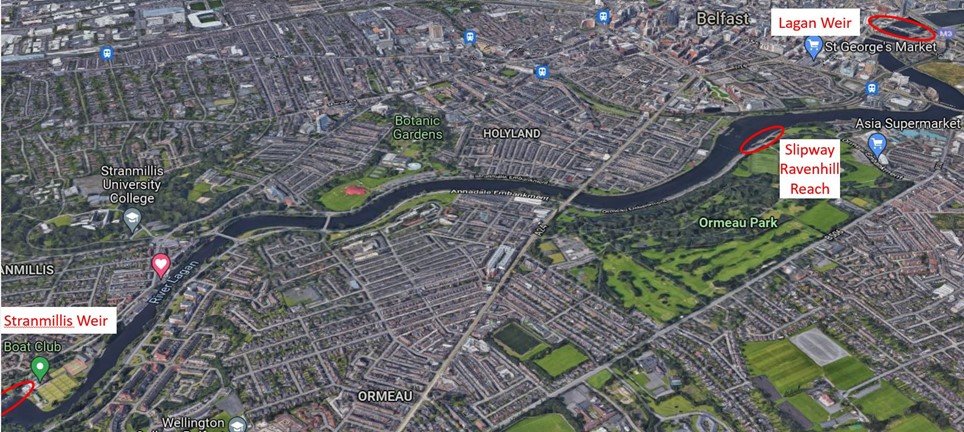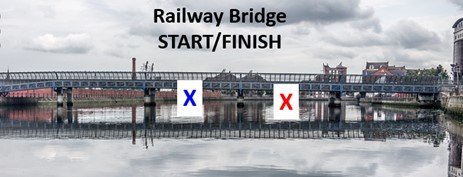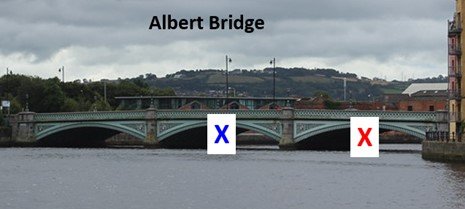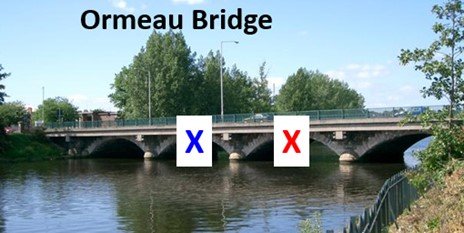Whitehead Coastal Rowing Club
Standard Operating Procedures – Rowing on the Lagan
Introduction
The stretch of the Lagan in Belfast between the Lagan Weir and Stranmillis Weir (about 4km in length) is a safe and convenient place to row. This part of the river is tidal but the Lagan Weir ensures a minimum water level so that a wide stretch of water can be rowed at all times of the day and year. The river sits below the embankments at Stranmillis, Ormeau and Ravenhill so that it is sheltered meaning a coastal rowing boat can safely row in all but the very worst weather.
Advance Planning
The WCRC committee will approve two organisers for each outing (preferably not the same each time) who will have responsibility for the planning, overseeing the operation, and participating in the rowing/coxing. The organisers will be responsible for:
Checking that the river will be open and accessible. Notice of river closure or restricted access can be found at - www.communities-ni.gov.uk/articles/river-notices-and-lagansideevents
The weather conditions will be suitable for rowing
Members (or friends/family) are available to tow there and back
Ensuring each boat has sufficient experience
Warn the rowers/coxes of any particular clothing and equipment requirements, and provide a schedule for the operation and who is expected when and where.
Making sure that the equipment and tools needed for the operation are available.
At least one organiser should supervise the boat/trailer setup and launch, and one to supervise the recovery and return/securing of boats at the boatyard.
Report any safety concerns, equipment malfunction, or damage to the committee
Personnel
The public slipway at Ravenhill is very steep and rarely cleaned. This makes launching and recovering boats tricky. At least 8 people are needed for this operation so usually a minimum of two boats will involved for each outing, meaning two people towing and two experienced coxes/coaches responsible for each crew (the experienced cox can be rowing but guiding an inexperienced cox).
A typical afternoon would involve 2 boats being used for 2 sessions, i.e. 2 x 2 = 4 separate crews, but there could be 3 boats and/or 3 sessions depending on demand. For a 2 x 2 session from 2-4 on a Saturday or Sunday an example Spond sign-up would be set up as follows, where organisers/tow-ers should sign up for more than one slot as appropriate.
Organisers: 2 spaces
12.30–15.00: meet boatyard, prepare boats/trailers, travel to Belfast, launch boat, row14.00-15.00
Towing: 2 spaces
Coxes: 2 spaces
Rowers: 6 spaces
15.00 – Changeover
15.00–17.30: meet Belfast, row 15.00–16.00, recover boat, return to boatyard and secure boats
Towing: 2 spaces
Coxes: 2 spaces
Rowers: 6 spaces
Spond will open initially for organisers, tow-ers and experienced coxes to sign up. It is only when these spaces are full, i.e. the outing is a safe and viable operation, that Spond will be opened up for rowers. After members have participated in outings to the Lagan a few times, they will have sufficient experience to be an organiser for a future outing.
Equipment
The following equipment will be required. This will normally be kept at Lourdes and/or the boatyard and the organisers should arrange to pick up in advance.
Trailer lights
Temporary number plate (can be done with some cardboard)
Boat straps, carpet strips, bungies, length of rope
Adjustable spanner/socket set, hammer
WD40, axle grease
Fenders, extra club life-jackets, cox bags
Preparing/Securing Boats
The following tasks must be completed before safe travel to and from Belfast:
Remove covers from the boats (or lift boats onto road trailers)
Push bow fully forward on trailer and tie securely
Use two ratcheted straps to secure the boat with carpet strips between the boat and straps
Put oars on rack and secure with bungies
Secure the No. 4 rower footplate flap with a bungy
Securely attach indicator/break lights and cables, and put on temporary number plate
Hitch up trailer and check lights are working
House and secure trailer jockey wheel ready for towing
Check rudders, bailers, fenders and all other essential equipment is being transported by car.
When the boat is returned to the boatyard:
Wash the boat and trailer (particularly the axles)
Replace the covers
Put cover on and sort out rollick holes and tie them up tightly
Check the cover is pulled tight at the stern and fitting properly all around (especially close to stanchions)
Tie the ropes around the hull of the boat nice and tight
Tie up the ropes to the oar stanchion to allow rain to run off.
Raise the front end of the trailer and chock both sides of the wheels with heavy blocks
Transporting the Boats
Anyone with a towbar, electrical fixing for lights on their car, and authorisation to tow a trailer on their driving licence can tow a boat to and from Belfast. There is no requirement to be able to reverse at any stage. Break and indicator lights should be tested before proceeding. Care should be taken to leave more stopping distance due to the additional weight of the trailer and a wide circle should be taken around tight corners.
The route to the river is M2 → M3 → Short Strand → Ravenhill Road → Ormeau Embankment
The entrance is on the right hand side just before the main entrance to the Ozone complex. Do not take the turning onto Ravenhill Reach, it is the next entrance.
Launching/Recovering the Boats
The slipway is very steep, therefore the stanchion oar holders on the trailer have to be removed before launch. Two experienced people will need to get in the water to guide and hold the boat as it goes in (take care as it will be very slippy). A rope should be tied onto the trailer so the rest of the team can lower the boat/trailer slowly into the water from dry ground. A similar operation should be employed to recover the boats.
The safest place for crew to get in and out of the boat is from the pontoon, although this requires the rowers to climb over the railings, so take care. The slipway can also be used to get in and out of the boat with extreme care. Once the boat is in the water it can be pulled around to the pontoon fending it off from the rocks/concrete. Alternatively, two competent rowers can get into the boat and manoeuvre it around.
When changing crews the cox should bring the boat alongside the pontoon commanding the shoreside rowers to ship their oars just before the pontoon is reached (take the oars out of the gate and bring into the boat).
Rowing on the Lagan
The Lagan is used extensively by many watersports – rowers, kayakers, dragon boats, SUP. At the weekends the river is primarily used in the mornings, so WCRC outings are best undertaken in the afternoon when the river is quiet. The general rules of the river are that boats stay on the right hand side in order that they pass Port to Port. Crews must also be aware of boats approaching them from the rear, which might be uncoxed boats, and shout warnings when needed. Care must also be taken when turning the boat so as not to impede other craft.
Crews should not go further downstream that the Queen’s Bridge as that would take the boat close to the weir. There are many bridges over the Lagan and it is important the correct archways are taken to avoid head-on collisions. The recommended archways to transit are as shown below, where this is the perspective going up river (towards Stranmillis).
Red – arch to take going up river;
Blue – arch to take going down river.
Very inexperienced coxes can stay between the Albert and Ormeau Bridges if needed.











